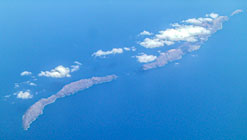|
Home
Page 1/6
Page 2/6 (this page)
Page 3/6
Page 4/6
Page 5/6
Page 6/6

|
Porto Santo, safe harbor
thanks to ice age sand
webpage 2/6
Text: Annemieke van Roekel
Uplifted seabed
Madeira, the Desertas and Porto Santo form the northern group of the "Madeira and Selvagens Archipelago".
The southern group includes the Canary Islands and the Selvagens. In terms of tectonics, the Selvagens are more
related to the Canary Archipelago, but the volcanism is much older (27-24 my, Ferreira et al., 1988).
The northern group is located on the SW part of the more than 1000 km long Madeira-Tore Rise,
an uplifted part of the seabed that is part of the African Plate (Nubian Plate), south of the Azores/
Gibraltar Transform Fault (AGFZ). The oceanic crust here is 140 million years old. AGFZ, a seismically
active fault line that forms the boundary between the African and Eurasian Plates, made history with the
infamous Lisbon earthquake of 1755.
Rift zone
The boat trip from Madeira to Porto Santo is already very worthwhile, sailing along the impressive
cliffs of the main island, Madeira. The entire island can be seen from the east, with the long
and low-lying foothills of the Ponta de São Lourenço Peninsula in the foreground (fig. 2). It is
the least steep and easternmost part of the WE-running rift zone, to which Madeira owes its
existence.

Fig. 2. Ponta de São Lourenço peninsula, eastern Madeira. Photo: A. van Roekel.
Here, a volcanically active period started 5.2 million years ago, in several phases.
The submarine rift zone bends SE at Ponta de São Lourenço and then runs parallel to that of
the Ilhas Desertas. This is a group of three fascinating islands, which lie in a
strikingly straight line, following a rift in the ocean crust. Topographical maps of the seabed
show that the ocean is max half a km deep and suggest a geological relationship between Madeira
and the Desertas. Geophysicists think that
Madeira and the Desertas are part of one volcanic complex (Geldmacher 2000).

Fig. 3. Aerial view of the Desertas Islands (Ilhas Desertas).
Photo: UNiesert via Wikimedia Commons/ Public domain.
Zino's petrel
For a moment I wonder whether a day trip (as tourist ships sail regularly) to the Desertas would
not have been better than a second visit to Porto Santo in one week (October 2020). Nature guides
live on the largest islet, Deserta Grande, keeping an eye on the endangered common
monk seals, and other unique fauna and flora.
Like many uninhabited ocean islands, the Desertas have a special fauna: the endemic and endangered
Hogna ingens spider species, the more than 12 cm wide 'Deserta Grande wolf spider',
as well as endangered seabirds, such as Zino's petrel (Madeira petrel).
Page 1/6
Page 2/6
Page 3/6
Page 4/6
Page 5/6
Page 6/6
Top photo: View to Ilhéu de Baixo from Miradouro das Flores.
© A. van Roekel
Copyright: Annemieke van Roekel
Last update: July 25, 2022
|